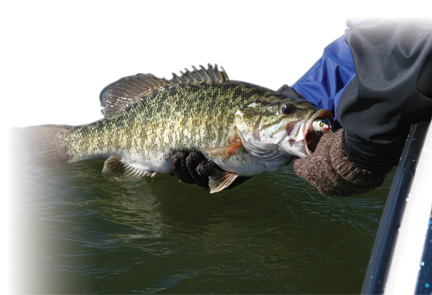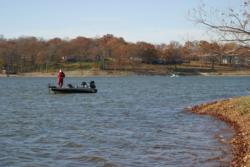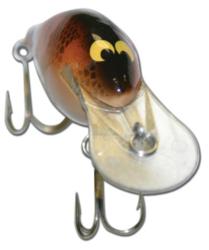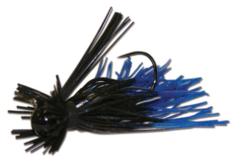Cold-water bass
Warm up to a few different lure presentations and catch those frigid fish

Frigid water and biting winds in late winter often persuade anglers to stay home on Saturdays and watch the NFL playoffs or college basketball. After all, those midday 30- and 40-degree temps feel about 40 degrees below zero when traveling 50 mph in a bass boat. What in the world could inspire someone to leave the recliner in front of the fireplace and hit the water in January and February … if their favorite lake isn’t frozen over?
Big bass!
Although their metabolism drastically slows and activity decreases when temperatures fall, bass still feed during the winter – especially larger fish. Anglers who brave the cold and fish during winter months generally agree that, while catch rates are lower, average fish weights are higher.
Many anglers believe the ONLY way to catch cold-water bass involves working a jig slower than a snail’s pace. Fishing a jig that slowly, for hours at a time in cold weather, may leave an angler half-comatose by the end of the day. While fishing jigs slowly is an effective technique for winter fish, other productive techniques break up the monotony and keep an angler’s blood flowing.
First of all, there is no need to get up at the crack of dawn and be on the water first thing in the morning. A few hours of direct sunshine does wonders for waking up cold, sluggish fish. Anglers may also notice that feeding times may be short and furious. So don’t be surprised if an hour goes by without a hit and then three casts produce three fish.
 Secondly, since large fish tend to be slightly more aggressive during cold weather than smaller fish, use larger baits. Big bass prefer big meals. Also, sluggish winter bass typically don’t put up the fight they’re known for in warmer seasons. The battle is still exciting, but the fish simply pull away rather than shake and jump. For this reason, lighter lines may be substituted for the big rope, even in fairly heavy cover.
Secondly, since large fish tend to be slightly more aggressive during cold weather than smaller fish, use larger baits. Big bass prefer big meals. Also, sluggish winter bass typically don’t put up the fight they’re known for in warmer seasons. The battle is still exciting, but the fish simply pull away rather than shake and jump. For this reason, lighter lines may be substituted for the big rope, even in fairly heavy cover.
Crankbaits and jerkbaits
A key to fishing crankbaits in cold weather – especially in the South – is targeting the south-facing side of points where shallow flats are in close proximity to deep water. If the south side is windblown, then conditions are even better. Why focus on the south-facing side of windblown points? Across the United States during winter months, the sun’s rays are most direct on the south side of the point. Furthermore, a southerly wind typically translates to a “warm” wind for much of the country.
The combination of sun and wind warms the shallow water along south-facing points. While the temperature change may be barely noticeable, fish will liven up during midday hours while the sun is highest and the water is warmest. Bass can be active for short spurts during these conditions. Catch the feeding time, and anglers forget it’s winter and think it’s July.
 Midsize to large, middiving crankbaits work best. Bass can actually be fairly shallow during midday, so use a crankbait that will not bury into the ground in shallow water but still taps the bottom a ways off the shoreline. Baits that dive in the 6- to 8-foot range typically work well. Retrieve crankbaits slowly, but fast enough to maintain good action and contact with the bottom.
Midsize to large, middiving crankbaits work best. Bass can actually be fairly shallow during midday, so use a crankbait that will not bury into the ground in shallow water but still taps the bottom a ways off the shoreline. Baits that dive in the 6- to 8-foot range typically work well. Retrieve crankbaits slowly, but fast enough to maintain good action and contact with the bottom.
As far as lure color is concerned, simply match the color of the bait to the forage. Many lakes experience a shad kill each winter. When the winter kill starts, fish go crazy over the dying, twitching shad. If fishing during this time, go with a shad-colored crankbait. Other color patterns that often produce are crawdad and bluegill.
According to Kellogg’s pro Dave Lefebre of Union City, Pa., crankbait patterns usually work well in the southern United States all winter. In the North, however, where water temperatures are colder, a jerkbait can be more effective because it can be fished more slowly.
“I use a big-bodied jerkbait in a clear baitfish pattern on lakes with grass,” Lefebre said. “They have to suspend perfectly. I like to get the bait down just above the grass and just switch it. Sometimes I don’t even move it and just let it drift. You want something that hardly moves. We can catch good numbers most of the winter using jerkbaits, even if the water temperature is 40 degrees or colder.”
Spoons
 If a pile of fish is located in a channel or on structure, vertically jigging a spoon works very well. Use the depth finder to place the spoon directly in front of the fish.
If a pile of fish is located in a channel or on structure, vertically jigging a spoon works very well. Use the depth finder to place the spoon directly in front of the fish.
When “popping” the spoon, don’t get too aggressive. Although the lure is in front of the fish, the water is still cold, and the fish are still a little on the slow side. Quickly pop the rod tip up a foot or two and let the spoon flutter back down. Pay close attention. The strike often comes on the fall when line is slack.
Spoons can really be effective on small lakes during the winter. Often, small bodies of water only have one or two deep channels meandering through the lake. Fish will stack up in the deeper water and are very easy to locate. Simply camp out on the channel and jig the spoon to your heart’s content.
Jigs
Back to the slow baits – jigs. Sometimes when the fishing gets tough, you just have to tie on the all-purpose, super-versatile jig. Just because the water is cold doesn’t mean bass abandon heavy cover. Pitching and casting heavy jigs around deep cover and slightly bouncing the lure periodically will tempt bass year-round.
 “When fishing wood (and other cover) during the winter, I go with a bigger jig – 7/16- or 9/16-ounce,” Lefebre said. “I also use a casting jig because it has a lighter wire hook. Sometimes in cold water you can barely feel the fish hit, and you want a sharp hook that can be set easier.”
“When fishing wood (and other cover) during the winter, I go with a bigger jig – 7/16- or 9/16-ounce,” Lefebre said. “I also use a casting jig because it has a lighter wire hook. Sometimes in cold water you can barely feel the fish hit, and you want a sharp hook that can be set easier.”
Bass will lightly inhale the bait, and fishermen will probably only feel a slight tap. Don’t wait for another tap. Set the hook. A second tap is the bass spitting out the bait.
“As far as colors go on winter jigs, I just stick with the common colors of black, blue and brown,” Lefebre said.
So don’t pack away the rods just because it’s a little chilly. There are fish to be caught.